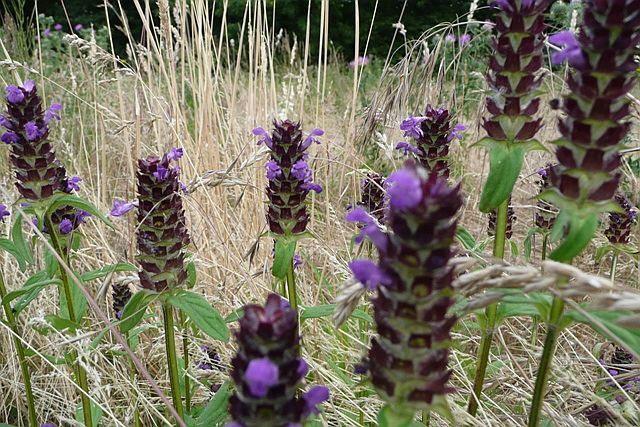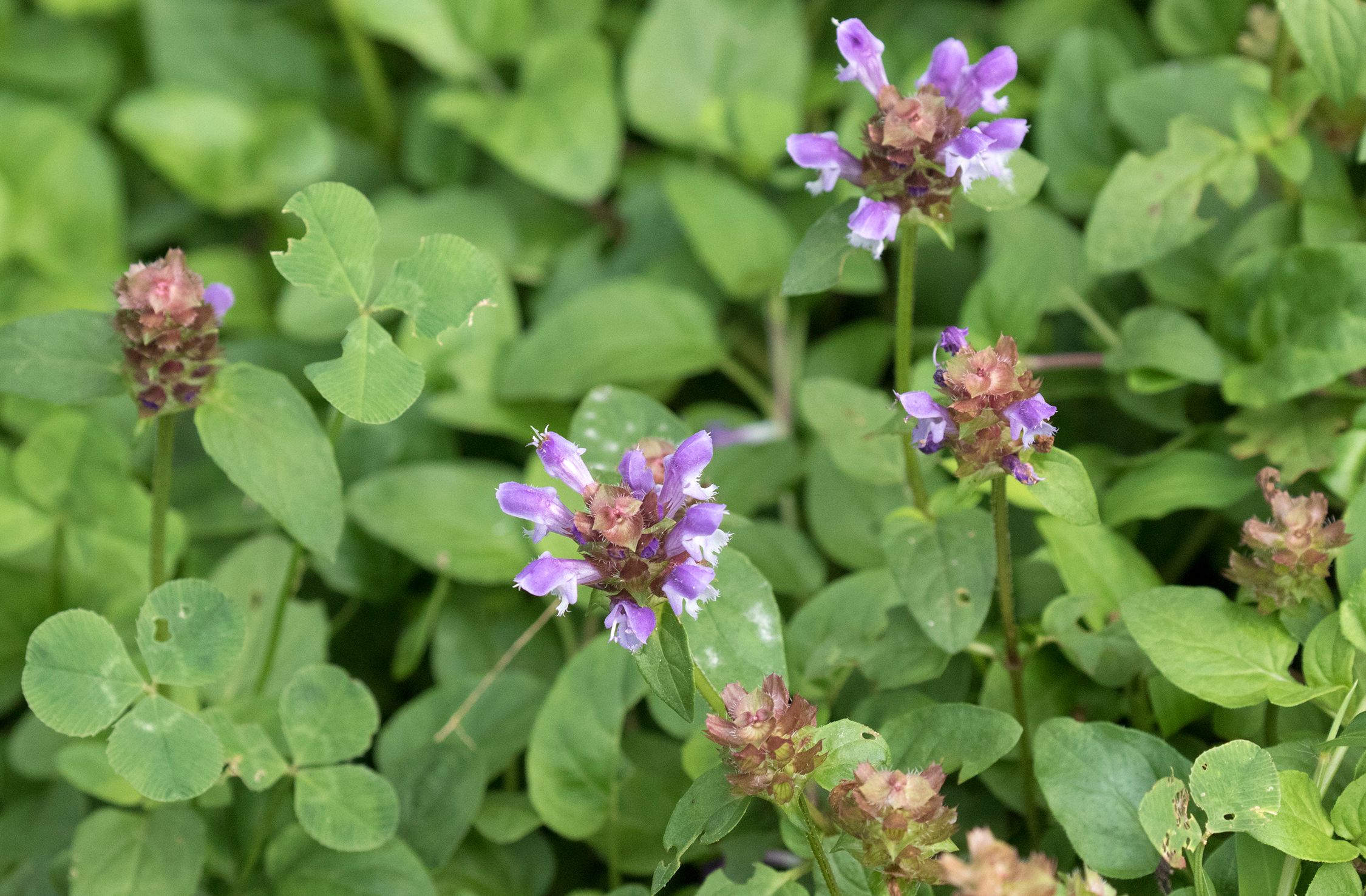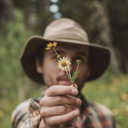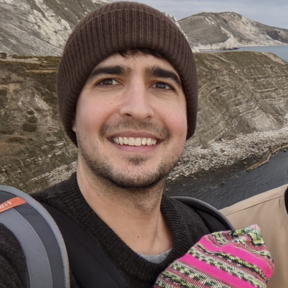

Nature identification courses
Effortlessly learn to recognise the species that grow around you, and remember what you learn forever... guaranteed!
Selfheal - Prunella vulgaris - identification and ultimate guide

Introduction
Selfheal (Prunella vulgaris) is a low-growing, violet-flowered plant commonly found in meadows, lawns, and woodland edges across the UK. As its name suggests, this wildflower has a rich history of medicinal use and was once revered in both European and East Asian herbal traditions. Its compact size and tightly clustered flowers belie a surprisingly potent chemical profile that has attracted growing scientific interest in recent years.
Quick Facts
- Common Name: Selfheal, Heal-all, Heart-of-the-Earth
- Scientific Name: Prunella vulgaris
- Family: Lamiaceae (Mint family)
- Habitat: Grasslands, roadsides, woodland edges, lawns
- Bloom Time: June to September
- Native Status: Native to the UK, Europe, Asia, and North America
- Conservation Status: Common, widespread
Interesting Tidbits
- The name "Selfheal" reflects the plant’s reputation in folk medicine as a cure-all.
- The latin name "prunella" derives from the German word for diptheria, which selfheal was traditionally used to treat.
- It was one of the most commonly recommended herbs in medieval European herbals.
- In traditional Chinese medicine, it is called "Xiakucao" and is still used today. It's an ingredient in one of China's most popular canned beverages, the herbal tea Wong Lo Kat.
Ecological Importance & Conservation
Selfheal plays a vital role in supporting pollinators, especially bumblebees, solitary bees, and some butterflies. Its long flowering season and compact flower heads make it a dependable nectar source from midsummer into early autumn. In closely mown lawns and meadows, it often survives where other wildflowers do not, making it a champion of urban and disturbed habitats.
The species is not under threat and is even being promoted in rewilding projects and biodiversity-focused lawn alternatives. It can be used in pollinator-friendly garden mixes and low-maintenance green roofs.
Overview & Identification
Selfheal is a low-growing, creeping perennial that spreads via rooting nodes. It forms mats of dark green, slightly hairy leaves and produces upright spikes of densely packed, tubular purple flowers. Each flower has a prominent hooded upper lip and a broader lower lip, aiding pollinator landing.

Botanical Description & Life Cycle
The plant features square stems typical of the mint family, and opposite pairs of ovate leaves with short stalks. Flowering spikes emerge from the leaf axils in early summer and can persist into autumn. Seeds are produced in nutlets, but the plant primarily spreads through creeping stems. It thrives in well-drained soil and can tolerate frequent mowing.
History & Cultural Significance
Selfheal has long been celebrated in herbal traditions across Eurasia. In medieval Europe, it was included in nearly every herbal manual and was used to treat wounds, ulcers, and sore throats. The 17th-century herbalist Nicholas Culpeper recommended it for everything from internal bleeding to liver complaints.
In Traditional Chinese Medicine, Selfheal—known as Xiakucao—is prescribed for conditions such as eye inflammation, fevers, and hypertension. It is listed in the Chinese Pharmacopoeia and remains in clinical use today.
Uses and Benefits
Selfheal is edible and the young leaves and stems can be eaten raw. Worth trying in a wild salad.
Modern scientific interest in Prunella vulgaris has focused on its diverse array of phytochemicals, including rosmarinic acid, ursolic acid, flavonoids, and triterpenoids. Here is what research has shown so far:
- Antioxidant Properties: Selfheal extracts have demonstrated strong free radical scavenging abilities in vitro, attributed to its phenolic compounds such as rosmarinic acid. These properties are well-documented in laboratory settings but need further clinical confirmation.
- Anti-inflammatory Effects: Ursolic acid and other constituents have shown anti-inflammatory activity in animal models. These effects suggest potential usefulness in inflammatory conditions, although no approved medical applications exist yet.
- Antiviral Potential: Some in vitro studies have shown that Selfheal extracts inhibit replication of viruses such as HSV-1 and HIV. These findings are promising but extremely preliminary and require caution in interpretation.
- Antitumour Activity: Several compounds in Selfheal, particularly triterpenoids and flavonoids, have demonstrated cytotoxicity against tumour cell lines in vitro. These studies are valuable for drug discovery but do not yet translate to proven therapeutic uses.
- Wound Healing: Traditional use for external wounds has been partially validated by animal studies showing improved skin regeneration and reduced inflammation when extracts are applied topically.
In summary, Selfheal is a pharmacologically rich plant with compelling lab-based evidence for several bioactive effects. However, clinical trials are sparse, and its practical health applications remain speculative at this stage.
Traditional & Folk Uses
Note: These uses are traditional and historical, and are not supported by modern clinical studies.
- Used in medieval Europe for healing cuts, bruises, and sores—often in poultice form.
- Infusions were taken for sore throats, fevers, and mouth ulcers.
- In Chinese medicine, decoctions are used to treat headaches, liver heat, and high blood pressure.
- Folk beliefs held that the plant could "heal all ailments," giving rise to its English and Latin names.
Growing & Gardening Tips
Selfheal is ideal for wildflower lawns, cottage gardens, and naturalised areas. It grows best in full sun to partial shade and tolerates a range of soils. It can survive mowing and foot traffic, making it a good lawn alternative for biodiversity-focused gardeners. Sow in spring or autumn, and water until established.
Frequently Asked Questions (FAQs)
- Is Selfheal edible? Yes, the leaves and flowers are technically edible but are usually consumed in teas or infusions rather than culinary dishes.
- Is Selfheal invasive? No, but it can spread efficiently in lawns and meadows through its creeping stems.
- Can I grow Selfheal in a pot? Yes, though it prefers space to spread. Use well-draining compost and provide regular water.
References & Further Reading
Why study with us?
Learning to effortlessly recognise the native species of your surrounding environment is one of the most rewarding things you will do in your lifetime. Being able to name the plants and other living things you see around you is the first step to becoming knowledgeable about and feeling an intimate connection with nature.
Unlike guidebooks or other methods of study, our flashcard sets are designed to guarantee that you acquire and retain the ability to recognise and name the species that you see around you in the most efficient way possible.
There is no other way to learn to recognise the native species so effectively or in so little time.
I've never been able to remember the names of plants and flowers despite owning many guidebooks. With the UK Wildflower course, learning and actually remembering them was incredibly easy!

Such an effective way of learning! I highly recommend this for anyone looking to master wildflower identification quickly. A very satisfying experience!

Instructions were really easy to follow. I'm only 9 days in and already I can recognise every single flower I see on my weekend hikes.

Thanks for the incredible resource! I'm amazed at how many plants I've learned in next to no time, and it was completely effortless. Very cool course.

About Us

Dara Javan,
owner
Hi, I'm Dara. I created wildflowercourses.com because I believe that everyone should be able to recognise the plants that grow around them, and that learning to do so should be easy. I also believe that experiencing the power of spaced repetition learning techniques can renew anyone's faith in their ability to learn.
I grew up in Purbeck, in Dorset, close to the most biodiverse square mile in the UK. Both my mum and stepdad worked for Natural England until their retirement and they filled me with a love for nature and for plants. I studied Natural Sciences at the University of Cambridge, which included plant sciences, ecology, and evolution. I now work for a sustainability education start-up.
I live in Dorset with my fiancee and our twin baby boys.